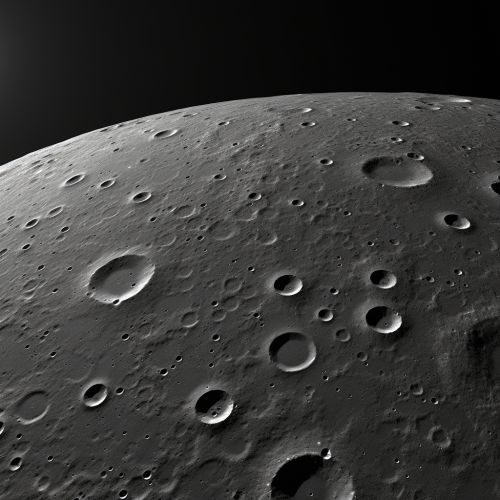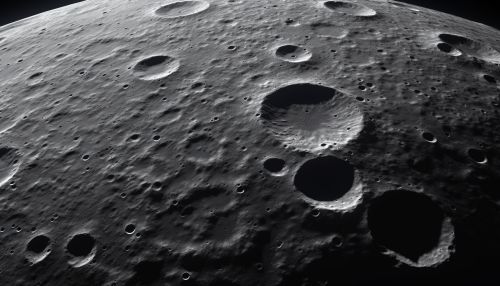Lunar geology
Introduction
Lunar geology, also known as selenology, is the scientific study of the geological aspects of the moon. The moon, being Earth's closest celestial neighbor, has been a subject of interest for geologists and astronomers alike. The study of lunar geology provides insights into the formation and evolution of the moon, its internal structure, and the processes that have shaped its surface over billions of years.
Formation and Evolution
The most widely accepted theory about the moon's formation is the giant-impact hypothesis, also known as the Theia Impact. According to this theory, a Mars-sized body named Theia collided with the early Earth around 4.5 billion years ago. The debris from this impact eventually coalesced to form the moon.
Over the course of its history, the moon has undergone several stages of geological evolution. The earliest stage, known as the pre-Nectarian era, is characterized by the formation of the moon's crust and the oldest known impact basins. This was followed by the Nectarian era, during which the Nectaris Basin and many other large basins were formed. The subsequent Imbrian era saw extensive volcanic activity, leading to the formation of the moon's maria, or large, dark basaltic plains. The Eratosthenian and Copernican eras, the most recent stages of lunar evolution, are marked by a decrease in volcanic activity and a continued process of impact cratering.


Lunar Crust
The moon's crust is primarily composed of rocks such as anorthosite and basalt. Anorthosite is a type of igneous rock that is rich in plagioclase feldspar, while basalt is a volcanic rock that is rich in minerals like pyroxene and olivine. The thickness of the lunar crust varies across the moon's surface, with an average thickness of about 50 kilometers.
The lunar crust is also home to a variety of impact craters, which are formed by the collision of asteroids and comets. These craters range in size from small pits to large basins spanning hundreds of kilometers. Some of the most prominent craters include Tycho, Copernicus, and Aristarchus.
Lunar Maria
The lunar maria are large, dark plains on the moon's surface that were formed by ancient volcanic eruptions. These regions are composed of basalt, a type of volcanic rock that is rich in iron and magnesium. The maria cover about 16% of the moon's surface, primarily on the near side.
The formation of the maria is believed to have occurred between 3 and 4 billion years ago, during a period of intense volcanic activity. The lava that erupted during this time spread out across the moon's surface, filling in low-lying areas and creating the flat plains that we see today.
Lunar Highlands
The lunar highlands, also known as terrae, are the light-colored areas on the moon's surface. These regions are heavily cratered and are composed primarily of anorthosite, a type of rock that is rich in calcium and aluminum. The highlands cover about 83% of the moon's surface and are believed to represent the original crust of the moon.
The highlands are older than the maria and have a more complex geological history. They have been heavily impacted by meteorite impacts, which have created a multitude of craters and basins.
Lunar Regolith
The lunar surface is covered by a layer of loose, fragmented material known as regolith. This layer is composed of a mixture of fine dust, small rocks, and larger boulders. The regolith is the result of billions of years of meteorite impacts, which have shattered the lunar rocks into a fine powder.
The regolith plays a crucial role in lunar geology, as it provides a record of the moon's geological history. By studying the composition and distribution of the regolith, scientists can gain insights into the processes that have shaped the moon's surface.
Lunar Exploration
The study of lunar geology has been greatly aided by the exploration of the moon, both by unmanned spacecraft and by human astronauts. The Apollo missions of the 1960s and 1970s brought back samples of lunar rock and soil, providing invaluable data for understanding the moon's geology.
In recent years, missions such as NASA's Lunar Reconnaissance Orbiter and China's Chang'e program have continued to explore the moon, providing high-resolution images of the lunar surface and data on its composition and structure.
Future of Lunar Geology
The future of lunar geology looks promising, with several countries and private companies planning missions to the moon. These missions aim to further our understanding of the moon's geology, as well as to investigate the potential for using lunar resources.
One area of particular interest is the study of lunar water. Recent missions have provided evidence of water ice in permanently shadowed craters at the moon's poles. This water could potentially be used as a resource for future lunar bases or for producing rocket fuel.
